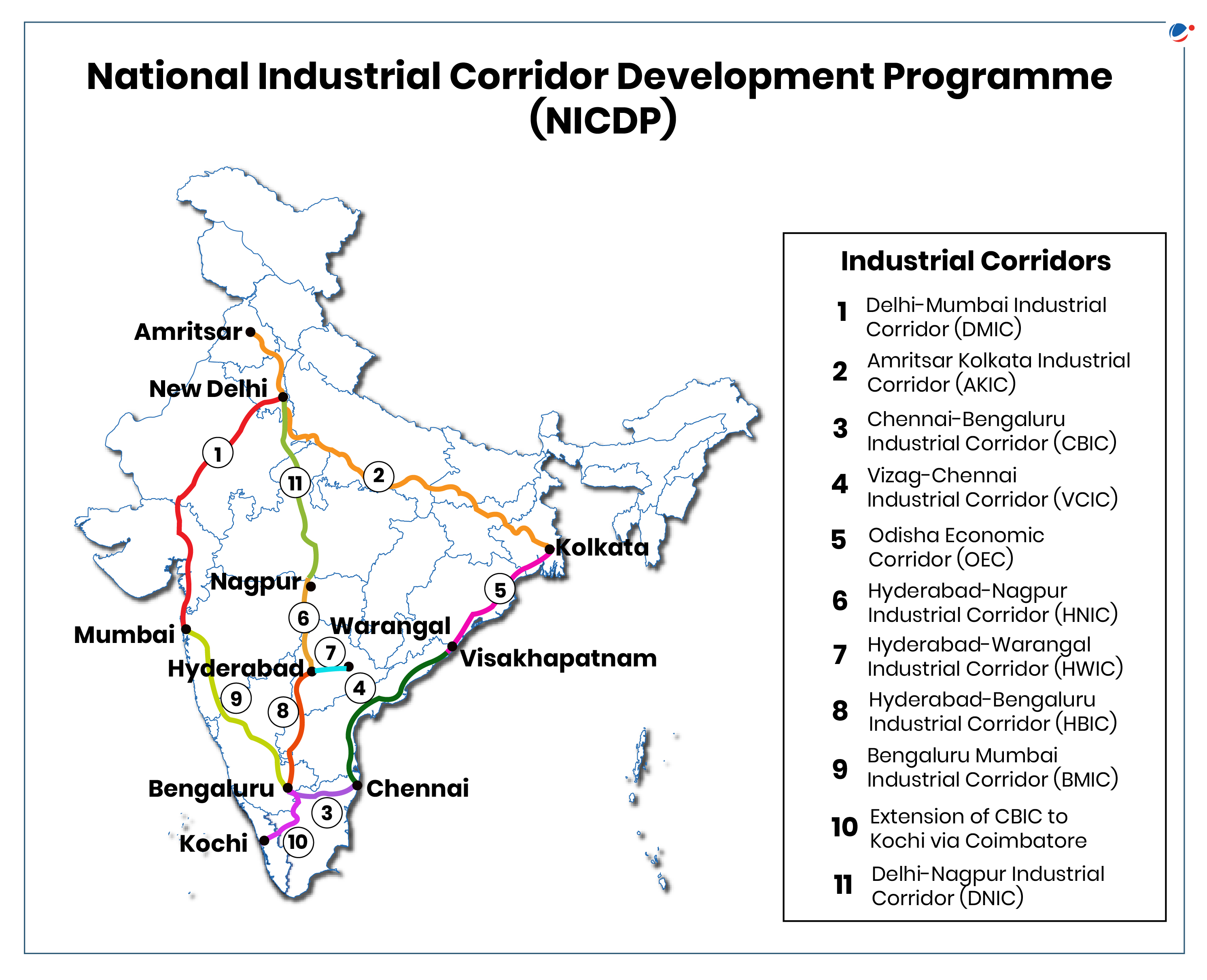Why in the News?
The union Cabinet has recently approved 12 new Industrial nodes/cities under National Industrial Corridor Development Programme.
More on the news
- The projects are strategically planned along six major corridors and across 10 states.
- These industrial areas will be located in Khurpia in Uttrakhand, Rajpura-Patiala in Punjab, Dighi in Maharashtra, Palakkad in Kerala, Agra and Prayagraj in UP, Gaya in Bihar, Zaheerabad in Telangana, Orvakal and Kopparthy in AP and Jodhpur-Pali in Rajasthan.
- The new industrial cities will be developed as Greenfield smart cities of global standards, built "ahead of demand" on the 'plug-n-play' and 'walk-to-work' concepts.
National Industrial Corridor Development Programme (NICDP)
- The National Industrial Corridor Development Programme began with the launch of Delhi-Mumbai Industrial Corridor (DMIC) in 2007.
- Seeks to create new industrial cities as "Smart Cities", where next-generation technologies seamlessly integrate across various infrastructure sectors.
- The industrial corridors will be designed to accelerate growth in the manufacturing sector and promote systematic urbanisation.
- These corridors will be supported by robust multi-modal connectivity and developed in collaboration with State Governments.
- Currently, the National Industrial Corridor Development Corporation (NICDC) oversees 11 industrial corridors in various stages of development.

Importance/Significance of Industrial Cities
- Attract Investments: NICDP aims to cultivate a dynamic industrial ecosystem and attract investments from domestic and foreign large anchor industries and MSMEs.
- Smart Cities and Modern Infrastructure: NICDP plans to develop greenfield smart cities, built ahead of demand, with advanced infrastructure for sustainable and efficient industrial operations, incorporating 'plug-n-play' and 'walk-to-work' concepts.
- Improving connectivity and transportation: Projects align with PM GatiShakti National Master Plan, integrating multi-modal connectivity infrastructure for seamless movement of people, goods, and services, with industrial cities serving as growth centers.
- Developing India as a key player in Global Value Chains (GVC): NICDP will offer developed land parcels ready for immediate allotment, facilitating domestic and international investors' establishment of manufacturing units.
- Employment Generation: NICDP is projected to generate significant employment opportunities, potentially creating 1 million direct and 3 million indirect jobs.
- Sustainable Development: The NICDP projects prioritize sustainability, utilizing ICT and green technologies to minimize environmental impact, aiming to create industrial cities that serve as models of environmental stewardship.
Challenges in development of Industrial corridors
- Disjointed economic/industrial planning and urban planning: Existing cities are unprepared for potential impacts of industrial corridors, and local governments are largely excluded from the planning process.
- Eg: Limited involvement of city planning authorities in Delhi-Mumbai Industrial Corridor planning.
- Governance: Special Purpose Vehicles (SPVs) operate independently of local governing bodies leading to the absence of clear demarcation of jurisdiction or responsibilities between the involved institutions.
- E.g. Tumakuru Industrial Township Limited, a SPV operates independently of local panchayats, municipal corporations, or town planning departments.
- Institutional Capacity: Long gestation period for new cities to emerge and become fully functional.
- Insufficient capacity and training among staff to manage upcoming urban transformation.
- Land Acquisition: The India Infrastructure Report 2009 highlighted that 70 per cent of delays in infrastructure and other development were caused due to issues related to land acquisition.
- Conversion of land from agriculture to non-agricultural use: It is important to preserve fertile agricultural land, as once farm land is converted for urban– industrial use, it is irreversible—the land cannot be reconverted for farming.
- Environmental Concerns: Potential strain on existing water resources, particularly in water-scarce regions.
Way forward
- Involve local authorities and communities in planning processes to address site-specific challenges.
- Coordinate efforts among multiple state and non-state actors, including SPVs and industrial stakeholders.
- To faster land acquisition, farmers should be included in benefits from the projects by allotting small parcels of land around the projects and paying higher compensation rates than market rates.
- Need for a robust system to assess long-term implications of land conversion and more scattered spatial small clusters of industrial landscapes to reduce loss of fertile land.
- Establishing a robust framework for cooperation between central and state governments will facilitate better planning and execution of industrial corridors.
- Utilizing advanced technologies for project management and monitoring can improve efficiency, reduce costs, and enhance transparency in execution
Other initiatives related to infrastructure development
|



